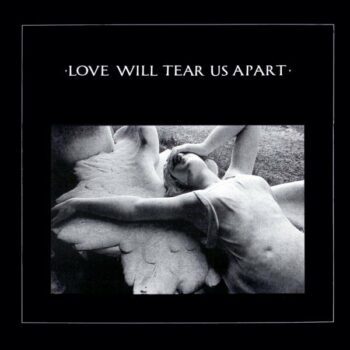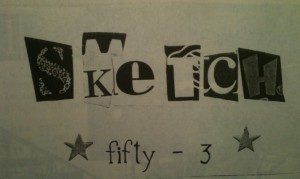
Ben, a cellist, sold copies of our ’zine, Sketch Fifty-three, for a quarter to the other kids in the Greater Boston Youth Symphony Orchestra—most of whom, though their moms drove them to rehearse Haydn or Mozart on weekend mornings, and though they toured Japan with Seiji Ozawa and Leonard Bernstein, seemed to know at least as much about punk and post-punk as Ben and I did. To try to stay ahead, we bought more records, wrote more reviews, wandered the brick factories past Institute Park taking more photos, published more issues. “[O]ne gets the impression that they are four college graduates who decided there are more important things to do than chase currency,” Ben remarked about Mission of Burma. “Propelled by a soaring intro, ‘Something Must Break’ climaxes with Stephen Morris’s cataclysmic drumming and [Ian] Curtis’s despairing vocals,” I observed about Joy Division. (“You’re only seven years too late,” complained an anonymous letter to the editors, written by someone who’d presumably discovered Joy Division the year before we had.) Ben’s orchestra friends gave him buttons advertising Boston bands, and sent me mail—my address was printed on our ’zine’s back page.
One girl—I’ll call her S.—became my pen pal: our correspondence began with her questions about my review of Public Image Limited’s Paris au Printemps LP, and my response, including a cassette with some songs from First Issue and Second Edition. I don’t want to romanticize letter-writing, or compare it favorably to e-mail, instant-messaging, texting, Skype. Still, the forty miles between S.’s house and mine meant that the post office delivered our letters—which we soon wrote each other almost daily—only a day or two later, and that slight but significant lull granted me whatever eloquence my sixteen-year-old self could muster. I ignored my homework, rummaged kitchen cupboards, scrawled in a spiral on a scavenged paper plate, then folded the plate in half, stapled the dimpled edge, inked S.’s address onto that crescent, and pressed a 25¢ stamp on it—about what AT&T then billed for a minute’s long-distance conversation, yet another reason we wrote letters instead of, as with local friends, tying up the family phone all night in those pre-call waiting years. Or, I used a brown lunch bag as an envelope, and filled it with small handwritten notes and pictures I’d scissored from magazines. S. mailed bulging, half-sized stationery envelopes in pastel colors. She told me about her sister, her annoying neighbors, her appreciation for the music of Kitaro. I cataloged my complaints and described my hometown ramblings. She drew cartoon sketches of herself. I sent more mix-tapes. Within a few months, in the middle of a five- or six-page letter, she wrote that she loved me.
“She said she loves you but she’s never even met you?” a friend said in the cafeteria the next day, when I bragged about it. “She’s a psycho!”
I’d recently acquired my first car—a 1980 Mercury Bobcat station wagon, paneled in fake wood and adorned with three bumper stickers I’d unpeeled on the back window: the PiL logo, the radio pulses of the neutron star from the cover of Joy Division’s Unknown Pleasures LP, and Newbury Comics’ grinning idiot—and driving to S.’s house meant making my first solo trip on the Interstate. Bridge and overpass construction funneled the Mass Pike traffic into single lanes, and I sped through narrow corridors of Jersey barriers, chucked change into the basket at the Newton tolls, then took Route 128 to Route 2.
S. and I didn’t call it a date: only parents used that word. But my hormonally-electrified fantasies about our meeting were mostly the obvious ones. “Is she cute?” I’d asked Ben: it seemed information as crucial as the bits of our lives S. and I’d confessed to each other all that spring. Her family’s house was a huge, shingled Victorian on a shady street that wound up a hill: my paper plates and postcards had gone here? I angled the tires against the curb, pulled up the parking brake, checked my mirrors one final time, and got out. S. already stood on the porch. “Hi,” she called, looking at me and then away. I probably did the same. Was she cute? She wasn’t not cute.
We walked through her neighborhood, looking at root-tilted squares of sidewalk and each other’s scuffed sneakers, asking awkward questions and mumbling answers. Breezes swung new leaves, and ragged shadows shifted over the pavement: had I been walking alone, I would’ve mentioned it in a letter to her, omitting the guy pushing his lawnmower who seemed to stare at us as we passed. Then her mom gave us a ride to the Alewife T station and we took the train to Harvard Square.
A sunny, pollen-scented Saturday in May: even we were roused by the Square’s finals-week energy to look at each other over sandwiches in a tiny café. S. slid vintage dresses along a rack at Oona’s, but didn’t buy any. We walked up the ramp at The Garage, wandered through displays of leather jackets, suede creepers, and Doc Martens at Allston Beat, and ended up at Newbury Comics. It’s tough to talk when you’re looking through so much vinyl, and impossible to make eye contact: I hunched over an imports bin. S. wandered away, maybe to the Kitaro section. I left the store with four or five new records, among them Joy Division’s “Love Will Tear Us Apart.”
The Red Line rattled us back to Alewife. There was no goodbye kiss, no damp hand shyly held. I have no idea whether my actual presence disappointed her, too. After that day our correspondence continued, for a little while, and we politely lied to each other about our meeting, but, in the absence of any sustaining fantasies, what else was there to say? S. and her family toured the northeast looking at colleges that summer, and she described these campus visits to me.  I went door-to-door for the Massachusetts Public Interest Research Group, asking people for money and signatures to stop a planned solid-waste incinerator, but I didn’t want to write about that experience to anyone. I got off work at ten each night, then hung out with friends at a late-night diner, or, if no one was around, listened to records. I already knew the Joy Division song, but now that I owned the single, it helped frame my summer: “And we’re changing our ways / Taking different roads.” I always preferred the B-side’s tauter version of the song, without the guitar flourishes, which meant I listened to “These Days” a lot, too: “We’ll drift through it all / It’s the modern age.” Like countless others before me, I both yearned for and cursed the affliction of modernity, and brooded over my mediated, irreconcilable, incomprehensible selves (incomprehensible to me, at least: my first day at MASSPIRG, a slightly elder co-worker took one look at me and said “I bet you like Echo and the Bunnymen and the Jam”). Ian Curtis may have been singing about his failing marriage and the affair he’d been pursuing, but that didn’t mean his lyrics couldn’t dramatize my own teenaged disquiet about “touching from a distance, further all the time.”
I went door-to-door for the Massachusetts Public Interest Research Group, asking people for money and signatures to stop a planned solid-waste incinerator, but I didn’t want to write about that experience to anyone. I got off work at ten each night, then hung out with friends at a late-night diner, or, if no one was around, listened to records. I already knew the Joy Division song, but now that I owned the single, it helped frame my summer: “And we’re changing our ways / Taking different roads.” I always preferred the B-side’s tauter version of the song, without the guitar flourishes, which meant I listened to “These Days” a lot, too: “We’ll drift through it all / It’s the modern age.” Like countless others before me, I both yearned for and cursed the affliction of modernity, and brooded over my mediated, irreconcilable, incomprehensible selves (incomprehensible to me, at least: my first day at MASSPIRG, a slightly elder co-worker took one look at me and said “I bet you like Echo and the Bunnymen and the Jam”). Ian Curtis may have been singing about his failing marriage and the affair he’d been pursuing, but that didn’t mean his lyrics couldn’t dramatize my own teenaged disquiet about “touching from a distance, further all the time.”
Sketch Fifty-three’s final number, published that fall, included—among illegally-reproduced copies of Kevin Cummins’s photographs of Joy Division looking serious among the concrete structures of Manchester, and Ben’s and my photographs of ourselves looking serious among the concrete structures of our own post-industrial hometown—a poem by my new girlfriend. I’d met her over the summer: she stood outside a liquor store, cursing and shouting at the clerk that had refused her fake ID, and then she noticed—I swear—the Unknown Pleasures sticker on my car. In a last record review, in an act of unwitting self-awareness, I claimed that Joy Division’s 1979 single “Transmission” was a song “dealing with alienation, hypocrisy, and confusion.” I can’t remember if I ever mailed S. a copy of the issue.




